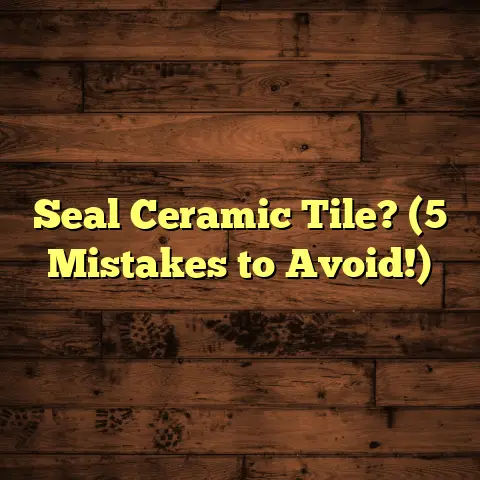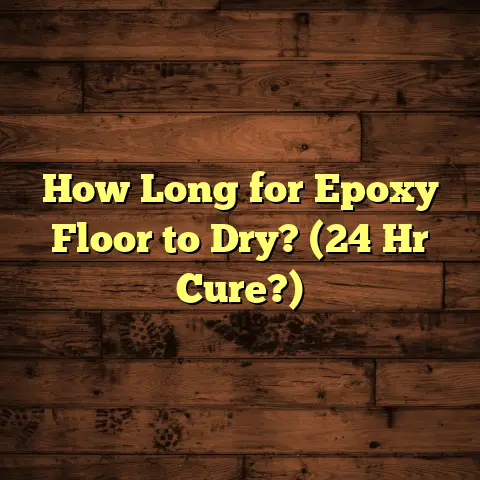Waterproof Flooring Basics (4 Water Test Secrets!)
Have you ever wondered how some homes remain dry and cozy even in the heaviest of rains, while others seem to succumb to moisture problems and water damage?
I’ve seen it firsthand, countless times in my years as a flooring contractor.
It’s heartbreaking to watch homeowners deal with the aftermath of water damage.
That’s why I’m so passionate about waterproof flooring – it’s a game-changer!
Introduction: Your Shield Against Water Woes
Water damage is a silent threat.
It can sneak into your home through leaks, floods, or even just high humidity.
With climate change bringing more extreme weather, and plumbing issues always lurking, the risk is only increasing.
Waterproof flooring isn’t just a trend.
It’s a proactive solution.
It’s an investment in the long-term health and value of your home.
Think of it as a shield, protecting your investment from the unseen enemy of moisture.
In this article, I’m going to share my secrets for choosing the right waterproof flooring.
I’ll walk you through simple water tests you can do yourself, and explain why they’re so important.
Section 1: Understanding
Waterproof Flooring
Let’s start with the basics.
What exactly is waterproof flooring?
Simply put, it’s flooring that’s impervious to water.
Unlike water-resistant flooring, which can handle splashes and spills for a short time, waterproof flooring can withstand prolonged exposure to moisture without damage.
This makes it ideal for areas prone to dampness, like bathrooms, kitchens, basements, and laundry rooms.
Types of Waterproof Flooring
There’s a wide range of waterproof flooring options available these days, each with its own pros and cons.
Here are some of the most popular:
-
Luxury Vinyl Plank (LVP) and Tile (LVT): LVP and LVT are engineered products designed to mimic the look of hardwood or tile. They’re incredibly durable, scratch-resistant, and, most importantly, 100% waterproof.
I often recommend LVP for its versatility and realistic wood-look options.
-
Sheet Vinyl: This is your classic waterproof option, often found in bathrooms and kitchens. It comes in large rolls, minimizing seams and creating a virtually impenetrable barrier to water.
-
Tile (Ceramic and Porcelain): Tile is a time-tested waterproof material. When properly installed with sealed grout, it’s virtually impervious to water. Porcelain tile is denser and less porous than ceramic tile, making it an even better choice for wet areas.
-
Waterproof Hardwood: Yes, you read that right! Thanks to advances in technology, there are now hardwood options that are engineered to be waterproof. These usually involve a specialized core and water-resistant finish.
While pricier, they offer the beauty of real wood with the protection of waterproof technology.
The Science Behind the Shield
How do these materials actually resist water?
It all comes down to their composition and construction.
-
Vinyl: Vinyl is inherently waterproof. It’s a synthetic material that doesn’t absorb water. LVP and LVT often have multiple layers, including a waterproof core and a wear layer for added durability.
-
Tile: Tile is fired at high temperatures, making it incredibly dense and non-porous. The glaze on the surface further protects it from water penetration. The key is proper grout sealing to prevent water from seeping through the grout lines.
-
Waterproof Hardwood: These engineered hardwoods typically have a waterproof core made of materials like stone-plastic composite (SPC) or wood-plastic composite (WPC). The core is then topped with a veneer of real hardwood and a durable, water-resistant finish.
Benefits Beyond Water Resistance
Choosing waterproof flooring offers a ton of advantages:
-
Durability: Waterproof flooring is built to last. It can withstand heavy foot traffic, scratches, and dents, making it a great choice for busy households.
-
Lower Maintenance: Cleaning is a breeze! Most waterproof floors can be easily wiped clean with a damp mop and mild detergent. No more worrying about spills soaking in and staining your floors.
-
Improved Home Value: Investing in waterproof flooring can increase the value of your home, especially in areas prone to moisture problems. It’s a selling point that buyers appreciate.
-
Peace of Mind: Knowing your floors are protected from water damage gives you peace of mind. You can relax and enjoy your home without constantly worrying about leaks or spills.
Section 2: The Importance of
Water Testing
Now, let’s talk about water testing.
Why is it so crucial?
I can’t stress this enough: not all flooring marketed as “waterproof” is created equal.
Some products perform better than others.
Water testing allows you to assess the waterproof capabilities of a flooring material before you invest in it.
It’s like a pre-flight check for your floors.
Why Test Before Installation?
Imagine installing beautiful new flooring, only to discover months later that it’s warping or peeling due to moisture.
It’s a costly and frustrating experience.
Water testing helps you avoid this nightmare.
By testing samples of different flooring options, you can identify the products that truly live up to their waterproof claims.
This is especially important if you’re installing flooring in a high-risk area like a basement or bathroom.
The Consequences of Ignoring
Water Resistance
Ignoring water resistance can lead to a whole host of problems:
-
Mold and Mildew Growth: Moisture trapped under flooring can create a breeding ground for mold and mildew, which can cause health problems and unpleasant odors.
-
Structural Damage: Water can seep into subfloors and framing, leading to rot and structural damage.
-
Warping and Buckling: Water can cause flooring materials to warp, buckle, or peel, ruining their appearance and requiring costly repairs or replacement.
-
Reduced Lifespan: Water damage can significantly shorten the lifespan of your flooring, forcing you to replace it sooner than expected.
Don’t take the risk!
Invest a little time in water testing, and you’ll save yourself a lot of headaches and money in the long run.
Section 3: The 4 Water Test Secrets
Alright, let’s get to the good stuff!
I’m going to share four water test secrets that I’ve learned over years in the flooring business.
These tests are simple, effective, and you can do them yourself.
Secret 1: The Simple Water Drop Test
This is the easiest and quickest test you can perform.
How to Perform the Test:
-
Grab a sample of the flooring material you’re considering.
-
Place it on a flat surface.
-
Carefully drop a few drops of water onto the surface.
-
Observe what happens over the next few minutes.
What to Look For:
-
Beading: The water should form beads on the surface, indicating that it’s not being absorbed.
-
Absorption: If the water quickly soaks into the material, it’s a sign that it’s not very waterproof.
-
Surface Tension: Look for how the water interacts with the surface. Does it spread out, or does it stay in a tight droplet?
Which Flooring Materials Perform Best?
-
LVP and LVT: These typically perform very well in the water drop test, with water beading up on the surface.
-
Sheet Vinyl: Sheet vinyl should also show excellent water resistance.
-
Tile: Glazed tile will bead water, while unglazed tile may absorb it slightly.
-
Waterproof Hardwood: The performance of waterproof hardwood will depend on the quality of the finish. Look for tight beading.
Limitations:
This test is a good starting point, but it doesn’t tell the whole story.
It only assesses the surface’s water resistance.
Secret 2: The Plastic Sheet Method
This test is more comprehensive and helps you assess how well the flooring material protects the subfloor from moisture.
How to Conduct the Test:
-
Place a sample of the flooring material on a clean, dry surface.
-
Dampen a sponge or cloth with water and wipe the underside of the flooring sample.
-
Cover the flooring sample with a sheet of clear plastic wrap, taping down the edges to create a seal.
-
Leave it for 24-48 hours.
-
Remove the plastic wrap and examine the flooring sample and the surface underneath.
What to Look For:
-
Condensation: Check for condensation under the plastic wrap. This indicates that moisture is escaping from the flooring sample.
-
Dampness: Feel the surface underneath the flooring sample. Is it damp?
-
Warping or Discoloration: Inspect the flooring sample for any signs of warping, swelling, or discoloration.
Interpreting the Results:
-
Minimal Condensation and No Dampness: This is a good sign! It means the flooring material is effectively blocking moisture.
-
Significant Condensation and Dampness: This indicates that moisture is penetrating the flooring material and could potentially damage the subfloor.
-
Warping or Discoloration: This is a clear sign that the flooring material is not waterproof and should be avoided in wet areas.
Tips for Effective Interpretation:
-
Use a clear plastic sheet so you can easily see any condensation.
-
Make sure the surface underneath the flooring sample is clean and dry before starting the test.
-
Compare the results of different flooring samples side-by-side to see which performs best.
Limitations:
This test gives you a better idea of how well the flooring material protects against moisture penetration, but it’s still not a perfect test.
Secret 3: The Water Soak Test
This is the most extreme test, and it will really put your flooring material to the test.
How to Perform the Test:
-
Cut a small sample of the flooring material.
-
Weigh the sample and record the weight.
-
Submerge the sample completely in a container of water.
-
Leave it to soak for 24-48 hours.
-
Remove the sample from the water and pat it dry.
-
Weigh the sample again and record the weight.
-
Observe any changes in the sample’s appearance.
Analyzing the Results:
-
Weight Gain: Calculate the percentage increase in weight. A significant increase indicates that the material absorbed a lot of water.
-
Visual Changes: Look for any signs of swelling, warping, discoloration, or delamination (separation of layers).
Guidelines on Soaking Time and Signs to Observe:
-
Soaking Time: 24-48 hours is a good standard soaking time. For particularly demanding applications, you can even soak the sample for a week.
-
Signs to Observe:
- Swelling: Any noticeable increase in the size of the sample is a bad sign.
- Warping: If the sample starts to bend or twist, it’s not waterproof.
- Discoloration: Changes in color can indicate that the material is reacting to the water.
- Delamination: If the layers of the material start to separate, it’s a clear sign that it’s not waterproof.
What the Results Reveal About Waterproof Capabilities:
-
Minimal Weight Gain and No Visual Changes: This indicates that the material is highly waterproof and can withstand prolonged exposure to moisture.
-
Significant Weight Gain and/or Visual Changes: This indicates that the material is not waterproof and should not be used in wet areas.
Limitations:
This test is very aggressive and can damage some flooring materials.
Only perform it on samples that you’re willing to sacrifice.
Secret 4: The Professional Moisture
Meter Evaluation
For the most accurate assessment of moisture levels in flooring, it’s best to consult a professional.
The Use of Professional Tools:
Professional flooring contractors use moisture meters to measure the moisture content of flooring materials and subfloors.
These meters use electrical resistance or capacitance to determine the amount of moisture present.
How This Method Provides Accurate Readings:
Moisture meters provide quantitative data that can be used to assess the risk of water damage.
They can detect moisture levels that are not visible to the naked eye.
The Importance of Hiring Professionals:
Hiring a professional flooring contractor to perform a moisture meter evaluation can help you:
-
Identify hidden moisture problems.
-
Assess the suitability of different flooring materials for your specific environment.
-
Ensure that your flooring is installed properly to prevent future water damage.
Limitations:
While moisture meters are valuable tools, they should be used in conjunction with other assessment methods, such as visual inspections and water testing.
Section 4: Real-Life Applications and
Case Studies
Let’s bring this all to life with some real-world examples.
I’ve seen firsthand how waterproof flooring can transform homes and solve water-related problems.
Example 1: The Flooded Basement
I worked with a homeowner who had a recurring problem with basement flooding.
Every time it rained heavily, water would seep into the basement, damaging the carpet and creating a moldy environment.
We replaced the carpet with LVP flooring.
It completely transformed the space.
The basement is now dry, comfortable, and mold-free.
The homeowner can finally use the space without worrying about water damage.
Example 2: The Bathroom Renovation
I recently renovated a bathroom where the existing tile floor had cracked and the grout was crumbling.
Water was leaking through the cracks and damaging the subfloor.
We installed porcelain tile with sealed grout.
It created a beautiful and waterproof surface.
The homeowner is thrilled with the new bathroom and no longer has to worry about water damage.
Common Problems Homeowners Faced Before Switching:
-
Mold and Mildew: This is a common problem in damp areas like bathrooms and basements. Waterproof flooring can prevent mold and mildew growth by creating a barrier to moisture.
-
Warping and Buckling: Water can cause traditional flooring materials like hardwood and laminate to warp and buckle. Waterproof flooring is resistant to these problems.
-
Stains and Odors: Water can cause stains and odors in carpets and other porous flooring materials. Waterproof flooring is easy to clean and doesn’t absorb odors.
Section 5: Choosing the Right
Waterproof Flooring for Your Needs
Okay, so you’re convinced about the benefits of waterproof flooring.
But how do you choose the right one for your needs?
Here’s some guidance based on different environments:
-
Basements: LVP, LVT, and sheet vinyl are all excellent choices for basements. They’re durable, waterproof, and can withstand the damp conditions often found in basements.
-
Bathrooms: Porcelain tile is a classic choice for bathrooms. It’s waterproof, slip-resistant, and easy to clean. LVP and sheet vinyl are also good options.
-
Kitchens: LVP and LVT are popular choices for kitchens. They’re durable, waterproof, and can stand up to spills and heavy foot traffic.
Key Features to Consider:
-
Slip Resistance: This is especially important in bathrooms and kitchens, where water can make floors slippery. Look for flooring with a textured surface to improve traction.
-
Ease of Installation: Some waterproof flooring options, like LVP with a click-lock system, are relatively easy to install yourself. Others, like tile, require professional installation.
-
Overall Aesthetics: Choose a flooring material that complements your home’s decor and personal style. Waterproof flooring comes in a wide range of colors, patterns, and textures.
The Importance of Considering Local Climate Factors:
If you live in an area with high humidity or frequent flooding, it’s even more important to choose waterproof flooring.
Consider the specific challenges of your local climate when making your decision.
Conclusion: Your Path to a
Water-Resistant Home
Waterproof flooring is more than just a flooring option.
It’s an investment in the safety, comfort, and value of your home.
By understanding the basics of waterproof flooring and performing simple water tests, you can make informed decisions that will protect your home from water damage for years to come.
Don’t wait until you have a water problem to take action.
Start testing your flooring options today and create a water-resistant home that you can enjoy for years to come.





